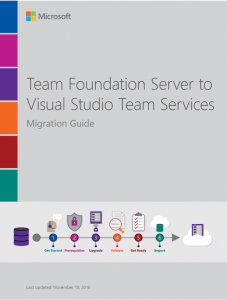Migration options
TFS 2018
When you decide to make the move from Azure DevOps Server to Azure DevOps Services, you might start fresh with an empty organization. Often, however, you will have existing code, work items, and other assets that you want to move. There are many approaches to doing this which vary in both the fidelity of the data transfer and the complexity of the process.
Prior to migrating data, review the differences that exist between Azure DevOps Server and Azure DevOps Services.
Option 1: Copy the most important assets manually
By far the easiest option for moving data into Azure DevOps Services is to manually copy your most important assets and start relatively fresh. This can be difficult when you are in the middle of a large project, but you can make it easier if you do some advance planning and schedule your move when it makes sense for your team.
For example, when the Azure DevOps team chose to move from Azure DevOps Server to Azure DevOps Services, we also decided to move from Team Foundation Version Control (TFVC) to Git. This required a fair bit of planning, but when we actually performed our migration, we created a new Git repo using the "tip" version of our TF VC sources, and left our history behind in Azure DevOps Server. We also moved our active work items, and left behind all our old bugs, completed user stories and tasks, and so on.
Here's the general process:
- Identify the most important assets that you need to migrate - typically source code, work items, or both. Other assets in Azure DevOps Server - build pipelines, test plans, and so forth - are harder to manually migrate.
- Identify a good time to make the transition.
- Prepare your target organizations. Create the organizations and team projects that you need, provision users, and so on.
- Migrate your data.
- Consider making the source Azure DevOps Server deployments read-only.
Option 2: High fidelity database migration.
The Azure DevOps Server & Azure DevOps Services product team provides a high fidelity data migration tool. A downloadable Migration Guide is available at https://aka.ms/AzureDevOpsImport.

Because the data migration tool operates at a database level, it can provide a very high fidelity migration. If you want to move your existing Azure DevOps Server data into Azure DevOps Services, we strongly recommend using this option.
Option 3: Using public API-based tools for higher fidelity migration
If for some reason you cannot use the data migration tool but still want a higher fidelity migration than Option 1, you can choose from a variety of tools that use public APIs to move data. Generally these tools can provide a higher fidelity migration than a manual copy of "tip" data, but they are still relatively low fidelity. For example:
- None of them will preserve the dates of TF VC changesets.
- Many of them will not preserve the changed dates of work item revisions.
- None of them will migrate all Azure DevOps Server artifacts.
In general, we only recommend this approach if the extra fidelity beyond a manual copy is critical. If you decide to take this approach, you might consider hiring a consultant who has experience with one or more of the tools. You should definitely consider doing a test migration before doing your final migration.
Many organizations need a very high fidelity migration for only a subset of their work. New work could potentially start directly in Azure DevOps Services. Other work, with less stringent fidelity requirements, could be migrated using one of the other approaches. You will have to weigh the pros and cons of the various approaches against your motivations for moving into Azure DevOps Services and decide for yourself what is the right strategy.